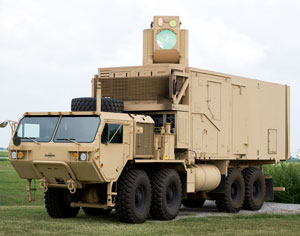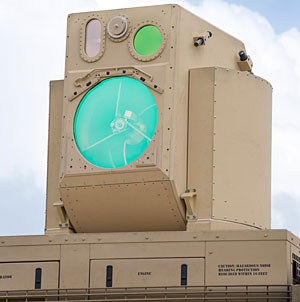

The Army High Energy Laser Mobile Demonstrator (HEL MD) underwent multiple test events between Nov. 18 and Dec. 10, at White Sands Missile Range, engaging more than 90 mortar rounds and several unmanned aerial vehicles in flight. What ‘engaged’ means? Has HEL-MD actually destroyed all those targets? – subscribe to find an answer
It was the first time the Army has tested this vehicle-mounted high-energy laser in the open, employing the system’s high power laser source and beam director, both mounted on a truck. Beside the laser system, an unspecified ‘enhanced multimode radar‘ supported the engagement by queuing the laser. The demonstration and testing confirms the capability of a mobile solid-state laser weapon system to counter mortars, UAVs, and intelligence, surveillance and reconnaissance sensors mounted on the UAVs, officials said.

The HEL MD is being developed to show directed-energy force-protection capabilities against rockets, artillery and mortars (RAM). It is also intended to protect against unmanned aerial vehicles (UAVs), and cruise missiles. These present a broad target set for the system’s target acquisition system, considering the wide variability of target velocities, maneuverability and radar signatures.
Mortars travel at low velocities for short ranges in high-arching trajectories. Artillery shells fly much faster, at a lower trajectory while UAVs fly slow and present an extremely low radar signature. Cruise missiles, on the other hand, often fly at subsonic speed but are hidden from radar detection for most of their flight path, as they usually fly at very low altitude. According to officials at Boeing, the integration of the multi-mode radar in the tests enable the developers to acquire both target data and provide intercept computation for future integration in laser weapon systems. The Boeing Company is the prime contractor for the HEL MD program.
Initial system effectiveness was proven through low- and medium-power test demonstration that took place in 2011. Currently under Phase II High-power testing, that have now been concluded at the High Energy Laser Systems Test Facility on White Sands Missile Range, the recent testing utilized a 10-kilowatt class laser. The 3 year program began September 2012 and is expected to last through 2015. In the future, a 50-kW class laser will be integrated into the HEL MD platform, officials said. The 50-kW laser is scheduled to be upgraded to a 100-kW class laser in subsequent demonstrations, they added. As part of the planned enhancement the supporting thermal and power subsystems will also be upgraded to support the increasingly powerful solid-state lasers, according to USASMDC/ARSTRAT officials. They said these upgrades will increase the effective range of the laser or decrease required lasing time on target.
















